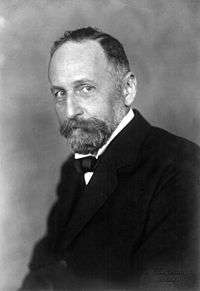Richard Willstätter
| Richard Willstätter | |
|---|---|
 | |
| Born |
Richard Martin Willstätter 13 August 1872 Karlsruhe, Baden, Germany |
| Died |
3 August 1942 (aged 69) Muralto, Locarno, Switzerland |
| Nationality | Germany |
| Fields | Physical chemistry |
| Institutions |
University of Munich ETH Zürich University of Berlin Kaiser Wilhelm Institute |
| Alma mater | University of Munich |
| Doctoral advisor |
Alfred Einhorn Adolf von Baeyer |
| Known for | Organic chemistry |
| Notable awards |
Nobel Prize for Chemistry (1915) Davy Medal (1932) Willard Gibbs Award (1933) Fellow of the Royal Society[1] |
| Spouse | Sophie Leser (1903-1908; her death; 2 children)[2] |
Richard Martin Willstätter, ForMemRS[1] (13 August 1872 – 3 August 1942) was a German organic chemist whose study of the structure of plant pigments, chlorophyll included, won him the 1915 Nobel Prize for Chemistry. Willstätter invented paper chromatography independently of Mikhail Tsvet.[3][4]
Biography
Willstätter was born into a Jewish family in Karlsruhe.[5] He was the son of Sophie (Ulmann) and Maxwell Willstätter, a textile merchant. He went to school there and, when his family moved, he attended the Technical School in Nuremberg. At age 18 he entered the University of Munich to study science and stayed for the next fifteen years. He was in the Department of Chemistry, first as a student of Adolf von Baeyer—he received his doctorate in 1894 - then as a faculty member. His doctoral thesis was on the structure of cocaine. Willstätter continued his research into other alkaloids and synthesized several of them. In 1896 he was named Lecturer and in 1902 Professor extraordinarius (professor without a chair).
In 1905 he left Munich to become professor at the ETH Zürich and there he worked on the plant pigment chlorophyll. He first determined its empirical formula.
In 1912 he became professor of chemistry at the University of Berlin and director of the Kaiser Wilhelm Institute for Chemistry, studying the structure of pigments of flowers and fruits. It was here that Willstätter showed that chlorophyll was a mixture of two compounds, chlorophyll a and chlorophyll b.[6]
In 1915 his friend Fritz Haber asked him to join in the development of poison gasses.[7] Willstätter would not work on poisons but agreed to work on protection. He and his coworkers developed a three layer filter that absorbed all of the enemy’s gasses. Thirty million were manufactured by 1917 and Willstätter was awarded the Iron Cross Second Class.[8]
In 1916 he returned to Munich as the successor to his mentor Baeyer. During the 1920s Willstätter investigated the mechanisms of enzyme reactions and did much to establish that enzymes are chemical substances, not biological organisms.
In 1924 Willstätter's career came to "a tragic end when, as a gesture against increasing antisemitism, he announced his retirement." According to his Nobel biography:[9] "Expressions of confidence by the Faculty, by his students and by the Minister failed to shake the fifty-three year old scientist in his decision to resign. He lived on in retirement in Munich....Dazzling offers both at home and abroad were alike rejected by him." His only research was with assistants who telephoned their results.
In 1939 Willstätter emigrated to Switzerland. He spent the last three years of his life there in Muralto near Locarno writing his autobiography. He died of a heart attack in 1942.
Willstätter's autobiography, Aus meinem Leben, was not published in German until 1949. It was translated into English as From My Life in 1965.[10]
Anecdote
In 1911 the fledgling American chemist Michael Heidelberger went to work for a year with Willstätter in Zurich. Willstätter helped his somewhat impecunious American student by sharing the cost of laboratory supplies with him, arranging that when expensive materials, such as silver nitrate, were to be bought, it was his turn to pay, while Heidelberger took turns buying cheaper materials like sulfuric acid. "Better training than that you couldn't have," Heidelberger summed up his experience with Willstätter. They remained friends for life.
See also
References
- 1 2 Robinson, R. (1953). "Richard Willstätter. 1872-1942". Obituary Notices of Fellows of the Royal Society. 8 (22): 609–626. doi:10.1098/rsbm.1953.0021. JSTOR 769233.
- ↑ http://www.nobelprize.org/nobel_prizes/chemistry/laureates/1915/willstatter.html
- ↑ Allen, W. A.; Gausman, H. W.; Richardson, A. J. (1973). "Willstätter-Stoll Theory of Leaf Reflectance Evaluated by Ray Tracing". Applied Optics. 12 (10): 2448–2453. doi:10.1364/AO.12.002448. PMID 20125799.
- ↑ Dées De Sterio, A. (1967). "Richard Willstätter, 25th anniversary of his death (25 Steptember 1942)". Munchener medizinische Wochenschrift (1950). 109 (39): 2018–2019. PMID 4874034.
- ↑ Stoltzenberg, Dietrich (2004). Fritz Haber: chemist, Nobel Laureate, German, Jew. Chemical Heritage Foundation. p. 203. ISBN 978-0-941901-24-6.
- ↑ Motilva, Maria-José (2008), "Chlorophylls - from functionality in food to health relevance", 5th Pigments in Food congress- for quality and health (Print), University of Helsinki, ISBN 978-952-10-4846-3
- ↑ L.F.Haber (1986). The Poisonous Cloud: Chemical Warfare in the First World War, Clarendon Press
- ↑ Van der Kloot, W. (2004). April 1915: Five future Nobel prize-winners inaugurate weapons of mass destruction and the academic-industrial-military complex. Notes Rec. R. Soc. Lond. 58: 149-160, 2004/
- ↑ Richard Willstätter - Biography at nobelprize.org
- ↑ Richard Willstätter: Aus meinem Leben, edited by A. Stoll, Verlag Chemie, Weinheim, 1949; English edition: From My Life, Benjamin, New York, 1965.
External links
- Presentation of the Nobel Prize to Willstätter
- Biography of Willstätter by the Nobel Institute
- On Plant Pigments, Willstätter's Nobel lecture
- Mahnmale, Gedenkstätten, Erinnerungsorte für die Opfer des Nationalsozialismus in München 1933-1945 pages 158-166
